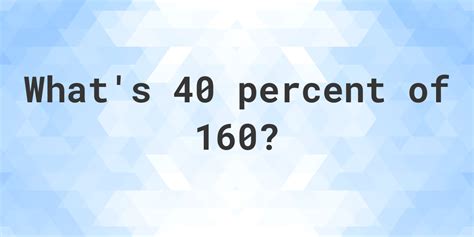What Is 40 Percent Of 160
Kalali
Apr 03, 2025 · 4 min read

Table of Contents
What is 40 Percent of 160? A Deep Dive into Percentages and Their Applications
Finding 40 percent of 160 might seem like a simple arithmetic problem, but understanding the underlying concepts opens doors to a world of practical applications in various fields. This article will not only solve the problem but also explore the broader context of percentages, their calculation methods, and their relevance in everyday life, business, and beyond.
What is a Percentage?
A percentage is a way of expressing a number as a fraction of 100. The word "percent" comes from the Latin "per centum," meaning "out of a hundred." Therefore, 40 percent (40%) means 40 out of 100, or 40/100, which simplifies to 2/5. Understanding this fundamental concept is key to solving percentage problems.
Calculating 40% of 160: Three Methods
There are several ways to calculate 40% of 160. Let's explore three common approaches:
Method 1: Using the Decimal Equivalent
This is often the most straightforward method. We convert the percentage to a decimal by dividing it by 100. 40% becomes 0.40 (or simply 0.4). Then, we multiply this decimal by the number we're interested in:
40% of 160 = 0.4 * 160 = 64
Therefore, 40% of 160 is 64.
Method 2: Using Fractions
As mentioned earlier, 40% is equivalent to the fraction 40/100, which simplifies to 2/5. We can then multiply this fraction by 160:
(2/5) * 160 = (2 * 160) / 5 = 320 / 5 = 64
Again, we find that 40% of 160 is 64.
Method 3: Using Proportions
This method is useful for understanding the underlying relationship between the percentage, the part, and the whole. We can set up a proportion:
40/100 = x/160
Where 'x' represents 40% of 160. To solve for 'x', we cross-multiply:
40 * 160 = 100 * x
6400 = 100x
x = 6400 / 100 = 64
Once again, we arrive at the answer: 40% of 160 is 64.
Real-World Applications of Percentage Calculations
The ability to calculate percentages is essential in countless situations:
-
Finance: Calculating interest on loans, savings accounts, and investments. Determining discounts on purchases, understanding tax rates, and analyzing financial statements all rely heavily on percentage calculations. For example, a 40% discount on a $160 item would result in a savings of $64.
-
Business: Analyzing market share, calculating profit margins, determining sales growth rates, and projecting future revenue all involve percentages. Businesses frequently use percentage changes to track performance and make informed decisions. A 40% increase in sales from one quarter to the next would represent significant growth.
-
Science: Expressing experimental results, analyzing statistical data, and representing proportions in various scientific studies often involve percentages. For instance, a scientist might report that 40% of participants in a study showed a positive response to a treatment.
-
Everyday Life: Calculating tips in restaurants, understanding sales tax, determining the percentage of ingredients in a recipe, and comparing prices all require an understanding of percentages. Calculating the percentage of your monthly income that goes towards rent is a practical application everyone should master.
-
Education: Calculating grades, expressing the performance of students on tests, and analyzing the success rate of programs all rely on the use of percentages. A student scoring 64 out of 160 on a test would have a 40% score.
Beyond the Basics: Percentage Increase and Decrease
While calculating a percentage of a number is fundamental, often we need to deal with percentage increases or decreases.
Percentage Increase: This refers to the increase in a value expressed as a percentage of the original value. For example, if a value increases from 100 to 140, the percentage increase is calculated as follows:
(Increase / Original Value) * 100% = ((140 - 100) / 100) * 100% = 40%
Percentage Decrease: This represents the decrease in a value expressed as a percentage of the original value. If a value decreases from 160 to 96, the percentage decrease is:
(Decrease / Original Value) * 100% = ((160 - 96) / 160) * 100% = 40%
Understanding Percentage Points
It's important to distinguish between percentage change and percentage points. A change of 10 percentage points is different from a 10% change. For example, if a value increases from 50% to 60%, it's increased by 10 percentage points, but this represents a 20% increase ((10/50) * 100%).
Advanced Percentage Applications
More complex scenarios involve compound interest, exponential growth and decay, and statistical analysis, all of which heavily utilize percentage calculations. Understanding these advanced concepts requires a stronger grasp of algebra and calculus but build upon the fundamental understanding of percentages.
Conclusion
Finding 40 percent of 160, while seemingly simple, serves as a gateway to understanding a crucial mathematical concept with wide-ranging applications. From everyday finances to complex scientific studies, the ability to calculate and interpret percentages is a valuable skill. Mastering these calculations empowers individuals to make informed decisions in various aspects of life, from managing personal finances to navigating the complexities of the business world. The examples provided in this article illustrate just a fraction of the many ways percentages impact our daily lives, highlighting the importance of developing a solid understanding of this fundamental concept. By mastering percentage calculations, you equip yourself with a powerful tool for navigating the numerical world around us.
Latest Posts
Latest Posts
-
Cuanto Es 80 Cm En Pulgadas
Apr 04, 2025
-
How Many Pounds Is 20 Killograms
Apr 04, 2025
-
What Percent Is 24 Of 40
Apr 04, 2025
Related Post
Thank you for visiting our website which covers about What Is 40 Percent Of 160 . We hope the information provided has been useful to you. Feel free to contact us if you have any questions or need further assistance. See you next time and don't miss to bookmark.
